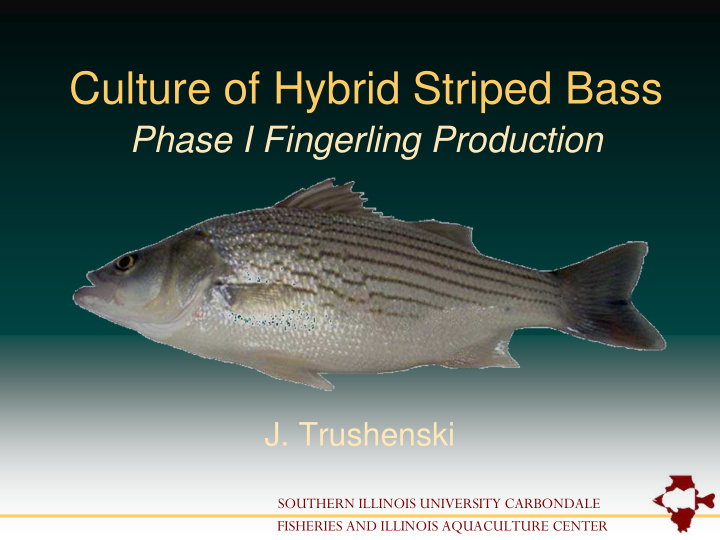



Culture of Hybrid Striped Bass Phase I Fingerling Production J. Trushenski SOUTHERN ILLINOIS UNIVERSITY CARBONDALE FISHERIES AND ILLINOIS AQUACULTURE CENTER
Recent Developments in the Production of Hybrid Striped Bass In 2002, over 60 U.S. producers 2003 Morone spp. production was up 9% from 2002* • Nearly 11.5 million pounds produced in 2003 Current outlook for aquaculture expansion is promising • Consumption of seafood is rising, up 1 pound per capita from 1998** • Feed costs are expected to decline through 2005*** • Due to increasing cost of imports, U.S. seafood exports are expected to be more competitive*** • Higher prices in 2004 will likely drive production expansion in 2005*** *NMFS Fisheries Statistics Division **USDA Aquaculture Outlook October 2004 ***USDA Aquaculture Outlook March 2005
Illinois Production 2003 Statistics • > 260,000 pounds produced • Market demands whole animal • $2.05-$5.00 per pound • Production cost ~ $1.20/lb Increased demand for fingerlings • Establish more producers • Limit fluctuating availability
Phase I Pond Culture General overview HSB fry are stocked 4-5 days post-hatch • ~ 3 mm in total length • Small gape • Obligate planktivores Phase I is complete after 4-6 weeks • Expect 1-2 inch fish Phase I represents a critical period of growth and development for HSB, and survival is dependent on pond management
Phase I Pond Culture General overview Careful management of ponds required to provide proper conditions and food for rapid growth of fry • Biotic and abiotic factors • Inorganic and organic fertilizers • Stimulate autotrophic and heterotrophic populations Provision of initial prey base is paramount to successful Phase I culture
Pond Criteria for Rearing Drainable ponds preferred • If using non-drainable ponds, eliminate unwanted fish and invertebrates prior to stocking Dimensions • Sizes vary 1 to 5 acres • 4 to 10 feet in depth • Bottom slope 1:100 rise/run • Bank slope 3:1 rise:run 1 1 3 3 1 1 100
Feeding Strategy After hatching, larval HSB feed endogenously on yolk sac • Yolk sac is fully absorbed after ~5 days Fry begin feeding on plankton according to gape size • Small zooplankton • Rotifers and cladocerans • Larger zooplankton • Cladocerans and copepods • Macro-invertebrates Transition to prepared feeds
Generalized Pond Food Web Fish Copepods ciliated protozoa dinoflagellates rotifers chain diatoms photosynthetic flagellated flagellates protozoa autotrophic heterotrophic bacteria bacteria particulate and dissolved organic matter
Fertilizers Fish Copepods ciliated protozoa dinoflagellates rotifers chain diatoms photosynthetic flagellated flagellates protozoa autotrophic heterotrophic bacteria bacteria particulate and dissolved organic matter
Fertilizer Types Inorganic • Nitrogen: calcium nitrate, potassium nitrate • Phosphorus: superphosphate, rock phosphate Organic • Manures: traditional livestock • Hays: alfalfa, bermuda, clover • Meals: cottonseed, corn, soybean
Food Web Stimulation Larval Fish Autotrophic Inorganic Fertilizer Phytoplankton Zooplankton
Food Web Stimulation Larval Fish Heterotrophic Bacteria and Protozoans Organic Fertilizer Zooplankton Aquatic Insects
Fertilization Regimes and Rates Management recommendations range • No fertilization • Organic fertilization • Inorganic fertilization • Combined inorganic and organic fertilization Inorganic fertilizer • 0.25-1.00 mg/L active ingredient/volume • Applied as needed Organic fertilizer • 500-1500 lb/ac • Applied in separate portions • Over 4-6 week culture period
Nutrient Ratios Maintaining a high N:P ratios • > 7:1 (N:P) • May inhibit unwanted phytoplankton (blue-green algae or cyanobacteria) Characteristics of blue-greens • May release toxins • May form unsightly mats that hamper seining efforts • Not a desirable food source for zooplankton
Zooplankton Trends Rotifers present 1-2 weeks post-flooding Cladocerans present after 2-3 weeks Copepods present after 3-4 weeks
Zooplankton Monitoring Sample prior to stocking and weekly throughout Phase I • Appropriate samplers • Desirable number: 500+ animals/gal
Stocking Ponds Stock fry at 4-5 days post-hatch • 100,000-200,000 fry/ac • Stock at night or late afternoon Time between stocking and first-feeding is a critical window for survival • Ponds must be prepared • Filled on time • Forage base established • Appropriate water temperature • HSB fry are fragile and must be carefully handled • Use plastic bags or move holding tanks to pond • Gradually acclimatize to pond conditions
HSB Fry are Small Relative to Other Fishes Common Name Fry Length (inches, mm) Hybrid Striped Bass 1/16-1/4”, 2-6 mm Fathead Minnow 5/32-1/4”, 4-6 mm Yellow Perch 3/16-9/32”, 5-7 mm Walleye 1/4-9/32”, 6-9 mm Channel Catfish 13/32-15/32”, 10-12 mm
Water Quality Daily measurements of temperature and oxygen levels Weekly measurements of various nitrogen and phosphorus compounds and pH
Optimum Water Quality Temperature • Maximum growth 25 -27C (77-81F) • < 15C (59F) low feed consumption and reduced growth • > 28C (83F) high feed consumption and poor feed conversion Dissolved oxygen • < 4 mg/L is detrimental • Paddlewheel aerators required • Tractor (PTO) driven paddlewheels will likely be necessary (1 per 4 ponds)
Optimum Water Quality Alkalinity and hardness • > 100 mg CaCO 3 /L preferred pH • Can tolerate 6 – 10 • Optimal growth 7 – 8.5 Ammonia • < 1 mg/L
Fry Monitoring Hurry up and wait! 2-3 weeks, sample ponds with a small, soft mesh (non-tarred) seine (1/16-1/8 inch)
Potential Problems Forage declines as fish consume zooplankton • Slow growth • Cannibalism among siblings Predacious insect establishment • Consume fish • Decreased production
Fingerling Harvest Harvest 4-6 weeks after stocking, or when fish become visible at bank • Alternatively, can begin feed training process by offering starter feed in ponds Expect 1-2 inch fish and variable survival (10-25%)
Phase I Harvest Grade to uniform size • Removes cannibals Options • Restock at reduced density for Phase II • ~ 10,000 fish/ac • Use same rearing ponds • Requires more ponds • Move fish to tank to • Feed train in tanks for Phase II • Sell fish at this size
Recommend
More recommend